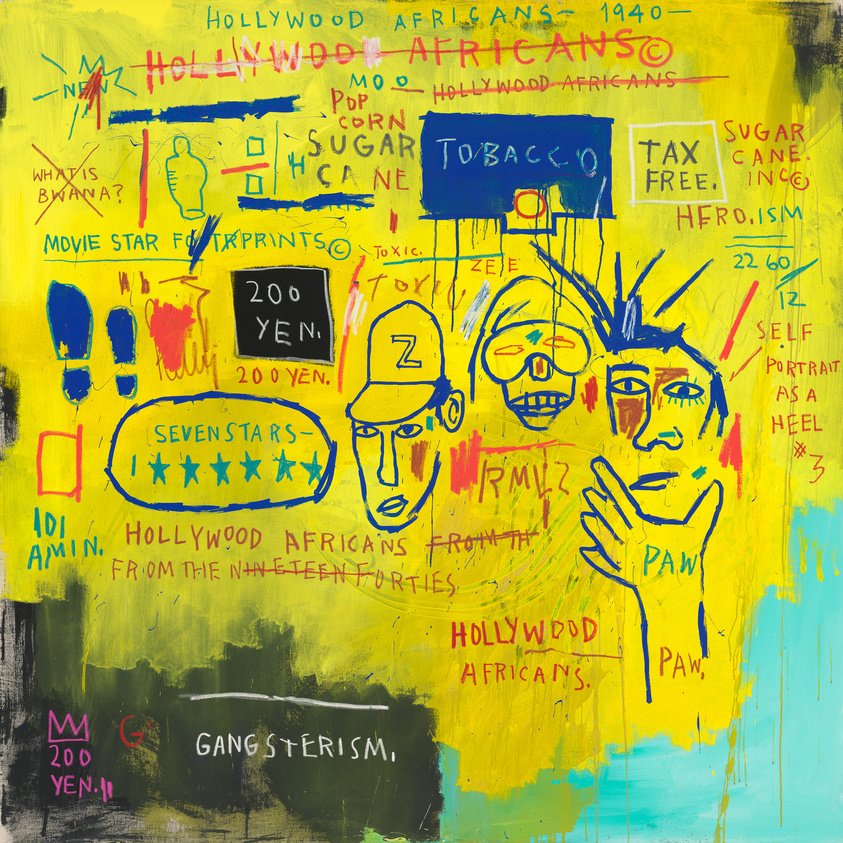Jean-Michel Basquiat’s Hollywood Africans: A Commentary on Race and Identity
Jean-Michel Basquiat’s tumultuous and inspiring personal life was as dynamic as his art. Born in 1960 in Brooklyn, New York, to a Haitian father and Puerto Rican mother, Basquiat was deeply influenced by his multicultural background. Growing up in a working-class family, Basquiat showed an early interest in art, using drawing as an outlet for his emotions and thoughts. However, his path to becoming one of the most influential artists of the 1980s was not easy. He dropped out of high school at 17 and began his career in the streets of New York City, making a name for himself with graffiti under the pseudonym SAMO. His early works were a blend of street culture and social commentary, elements that would remain central to his art throughout his short but impactful career.
Basquiat’s rise to fame in the art world was rapid, but it was also fraught with personal struggles. As an African American artist navigating a predominantly white art scene, he often felt torn between his cultural roots and the pressure to conform to the expectations of the mainstream art world. His work was filled with references to his heritage, race, and the difficulties of living as a Black man in America. His struggles with substance abuse, his intense personal relationships, and the overwhelming attention that came with fame all played a role in shaping his art. These experiences found expression in pieces like Hollywood Africans, which challenges the representation of Black artists in the broader cultural landscape.
Hollywood Africans, created in 1983, reflects Basquiat’s complex relationship with both his own identity and the way African Americans were depicted in popular culture, especially in Hollywood. The painting’s title directly references the experience of Black people in the film industry, where they were often confined to stereotypical roles or excluded altogether. Basquiat uses the painting as a powerful critique of Hollywood’s treatment of African Americans, using his distinct, raw visual language to examine race, power, and identity in a deeply personal way.
The painting features fragmented phrases and imagery, conveying the alienation Basquiat felt as a Black artist in a predominantly white art world. The phrase "Hollywood Africans" is not just a critique of the film industry but also a reflection of his own experience as a Black artist struggling for authenticity in an environment that often commodified and appropriated Black culture. Basquiat’s work was a refusal to be confined to any one category or stereotype; Hollywood Africans serves as a protest against the simplification of Black identity into consumable, marketable images.
Through Hollywood Africans, Basquiat conveyed the personal and professional tension he faced as a rising star in the art world. The painting’s chaotic aesthetic—characterized by aggressive brushstrokes, vibrant colors, and disjointed text—mirrors his inner turmoil and his confrontation with the superficiality of the art industry. It’s a vivid expression of his desire to assert his own voice and challenge the narratives that sought to limit him.
In reflecting on Basquiat’s life and legacy, Hollywood Africans serves as a powerful statement on race, identity, and representation. It’s a poignant reminder of the struggles Black artists face in navigating spaces where their contributions are often overshadowed by commercial interests. Through this painting, Basquiat not only confronted the misrepresentation of African Americans in Hollywood but also rejected the notion that Black artists should fit into any prescribed mold.
Related Rare Exhibits
Follow the By Our Hands: Artists of the Diaspora Exhibit Series
